Methods of Enquiry: Critical Analysis of Audit Practices in Finance
VerifiedAdded on 2022/09/12
|10
|2783
|19
Report
AI Summary
This report critically analyzes two academic research articles focusing on auditing practices in China and Egypt. The first article examines the implementation of audit committees and supervisory boards in China, using interviews to assess the effectiveness of auditing processes. It explores the roles of supervisory boards, independent directors, and audit committees within the Chinese legislative framework. The second article investigates audit committee activity and internal control quality in Egypt, considering the impact of external auditor size. Using questionnaires and quantitative analysis, the study assesses the relationship between committee activity, internal control quality, and the influence of Big 4 audit firms. Both articles highlight the importance of robust auditing practices and discuss limitations related to data interpretation and generalizability. The report concludes by emphasizing the value of these studies for understanding audit processes and informing improvements in the accounting and auditing industries. Desklib provides access to similar solved assignments and study tools.
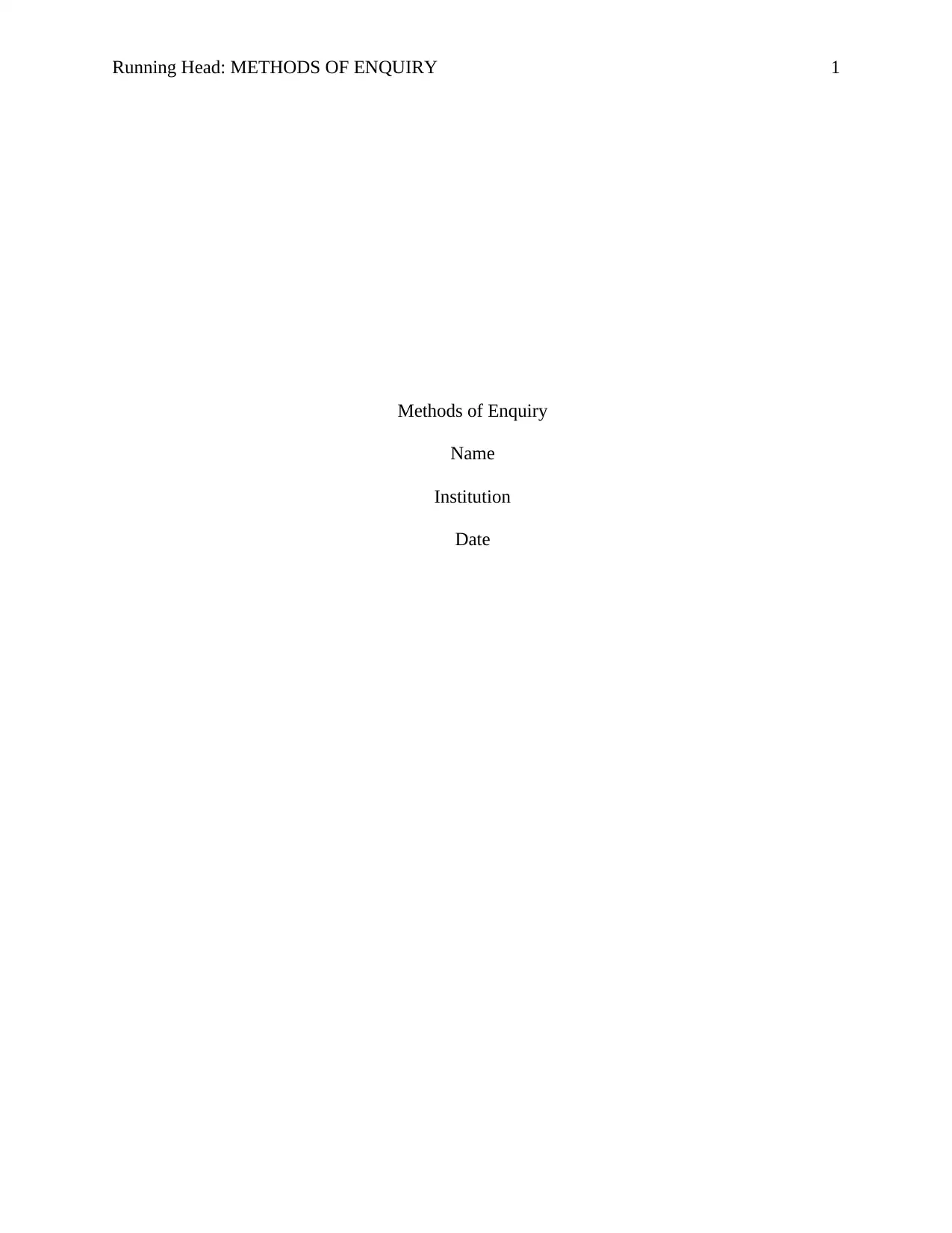
Running Head: METHODS OF ENQUIRY 1
Methods of Enquiry
Name
Institution
Date
Methods of Enquiry
Name
Institution
Date
Paraphrase This Document
Need a fresh take? Get an instant paraphrase of this document with our AI Paraphraser
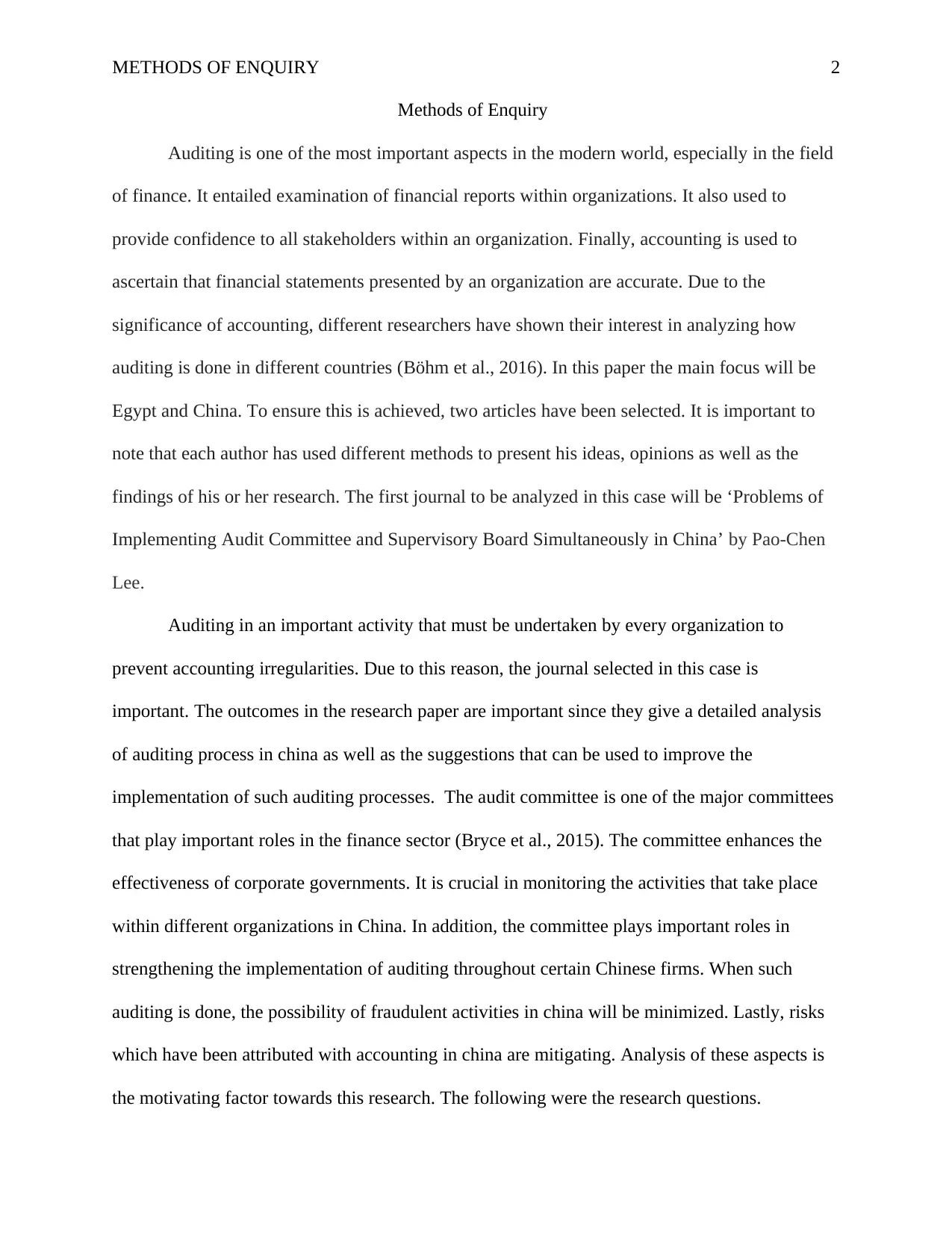
METHODS OF ENQUIRY 2
Methods of Enquiry
Auditing is one of the most important aspects in the modern world, especially in the field
of finance. It entailed examination of financial reports within organizations. It also used to
provide confidence to all stakeholders within an organization. Finally, accounting is used to
ascertain that financial statements presented by an organization are accurate. Due to the
significance of accounting, different researchers have shown their interest in analyzing how
auditing is done in different countries (Böhm et al., 2016). In this paper the main focus will be
Egypt and China. To ensure this is achieved, two articles have been selected. It is important to
note that each author has used different methods to present his ideas, opinions as well as the
findings of his or her research. The first journal to be analyzed in this case will be ‘Problems of
Implementing Audit Committee and Supervisory Board Simultaneously in China’ by Pao-Chen
Lee.
Auditing in an important activity that must be undertaken by every organization to
prevent accounting irregularities. Due to this reason, the journal selected in this case is
important. The outcomes in the research paper are important since they give a detailed analysis
of auditing process in china as well as the suggestions that can be used to improve the
implementation of such auditing processes. The audit committee is one of the major committees
that play important roles in the finance sector (Bryce et al., 2015). The committee enhances the
effectiveness of corporate governments. It is crucial in monitoring the activities that take place
within different organizations in China. In addition, the committee plays important roles in
strengthening the implementation of auditing throughout certain Chinese firms. When such
auditing is done, the possibility of fraudulent activities in china will be minimized. Lastly, risks
which have been attributed with accounting in china are mitigating. Analysis of these aspects is
the motivating factor towards this research. The following were the research questions.
Methods of Enquiry
Auditing is one of the most important aspects in the modern world, especially in the field
of finance. It entailed examination of financial reports within organizations. It also used to
provide confidence to all stakeholders within an organization. Finally, accounting is used to
ascertain that financial statements presented by an organization are accurate. Due to the
significance of accounting, different researchers have shown their interest in analyzing how
auditing is done in different countries (Böhm et al., 2016). In this paper the main focus will be
Egypt and China. To ensure this is achieved, two articles have been selected. It is important to
note that each author has used different methods to present his ideas, opinions as well as the
findings of his or her research. The first journal to be analyzed in this case will be ‘Problems of
Implementing Audit Committee and Supervisory Board Simultaneously in China’ by Pao-Chen
Lee.
Auditing in an important activity that must be undertaken by every organization to
prevent accounting irregularities. Due to this reason, the journal selected in this case is
important. The outcomes in the research paper are important since they give a detailed analysis
of auditing process in china as well as the suggestions that can be used to improve the
implementation of such auditing processes. The audit committee is one of the major committees
that play important roles in the finance sector (Bryce et al., 2015). The committee enhances the
effectiveness of corporate governments. It is crucial in monitoring the activities that take place
within different organizations in China. In addition, the committee plays important roles in
strengthening the implementation of auditing throughout certain Chinese firms. When such
auditing is done, the possibility of fraudulent activities in china will be minimized. Lastly, risks
which have been attributed with accounting in china are mitigating. Analysis of these aspects is
the motivating factor towards this research. The following were the research questions.
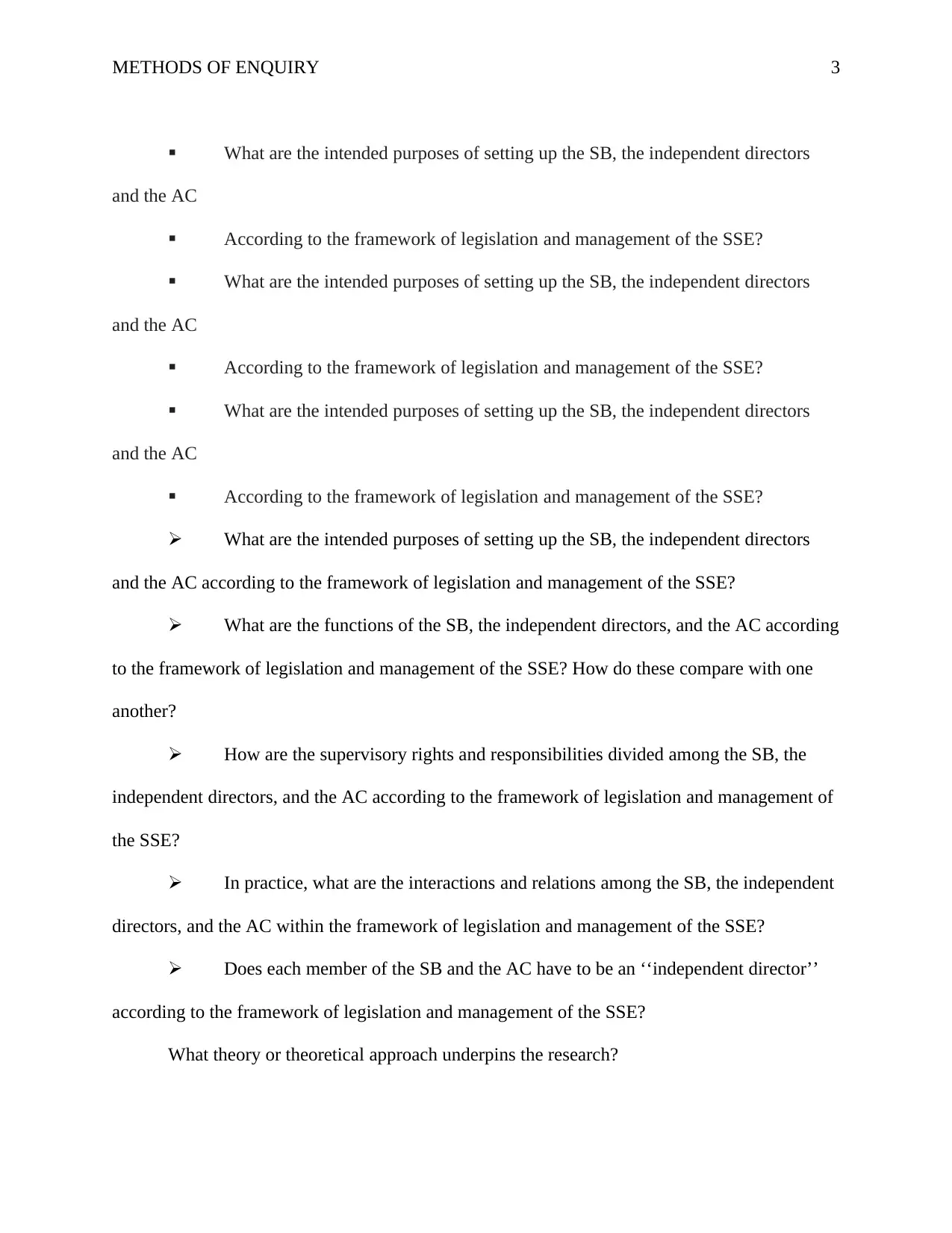
METHODS OF ENQUIRY 3
What are the intended purposes of setting up the SB, the independent directors
and the AC
According to the framework of legislation and management of the SSE?
What are the intended purposes of setting up the SB, the independent directors
and the AC
According to the framework of legislation and management of the SSE?
What are the intended purposes of setting up the SB, the independent directors
and the AC
According to the framework of legislation and management of the SSE?
What are the intended purposes of setting up the SB, the independent directors
and the AC according to the framework of legislation and management of the SSE?
What are the functions of the SB, the independent directors, and the AC according
to the framework of legislation and management of the SSE? How do these compare with one
another?
How are the supervisory rights and responsibilities divided among the SB, the
independent directors, and the AC according to the framework of legislation and management of
the SSE?
In practice, what are the interactions and relations among the SB, the independent
directors, and the AC within the framework of legislation and management of the SSE?
Does each member of the SB and the AC have to be an ‘‘independent director’’
according to the framework of legislation and management of the SSE?
What theory or theoretical approach underpins the research?
What are the intended purposes of setting up the SB, the independent directors
and the AC
According to the framework of legislation and management of the SSE?
What are the intended purposes of setting up the SB, the independent directors
and the AC
According to the framework of legislation and management of the SSE?
What are the intended purposes of setting up the SB, the independent directors
and the AC
According to the framework of legislation and management of the SSE?
What are the intended purposes of setting up the SB, the independent directors
and the AC according to the framework of legislation and management of the SSE?
What are the functions of the SB, the independent directors, and the AC according
to the framework of legislation and management of the SSE? How do these compare with one
another?
How are the supervisory rights and responsibilities divided among the SB, the
independent directors, and the AC according to the framework of legislation and management of
the SSE?
In practice, what are the interactions and relations among the SB, the independent
directors, and the AC within the framework of legislation and management of the SSE?
Does each member of the SB and the AC have to be an ‘‘independent director’’
according to the framework of legislation and management of the SSE?
What theory or theoretical approach underpins the research?
⊘ This is a preview!⊘
Do you want full access?
Subscribe today to unlock all pages.

Trusted by 1+ million students worldwide
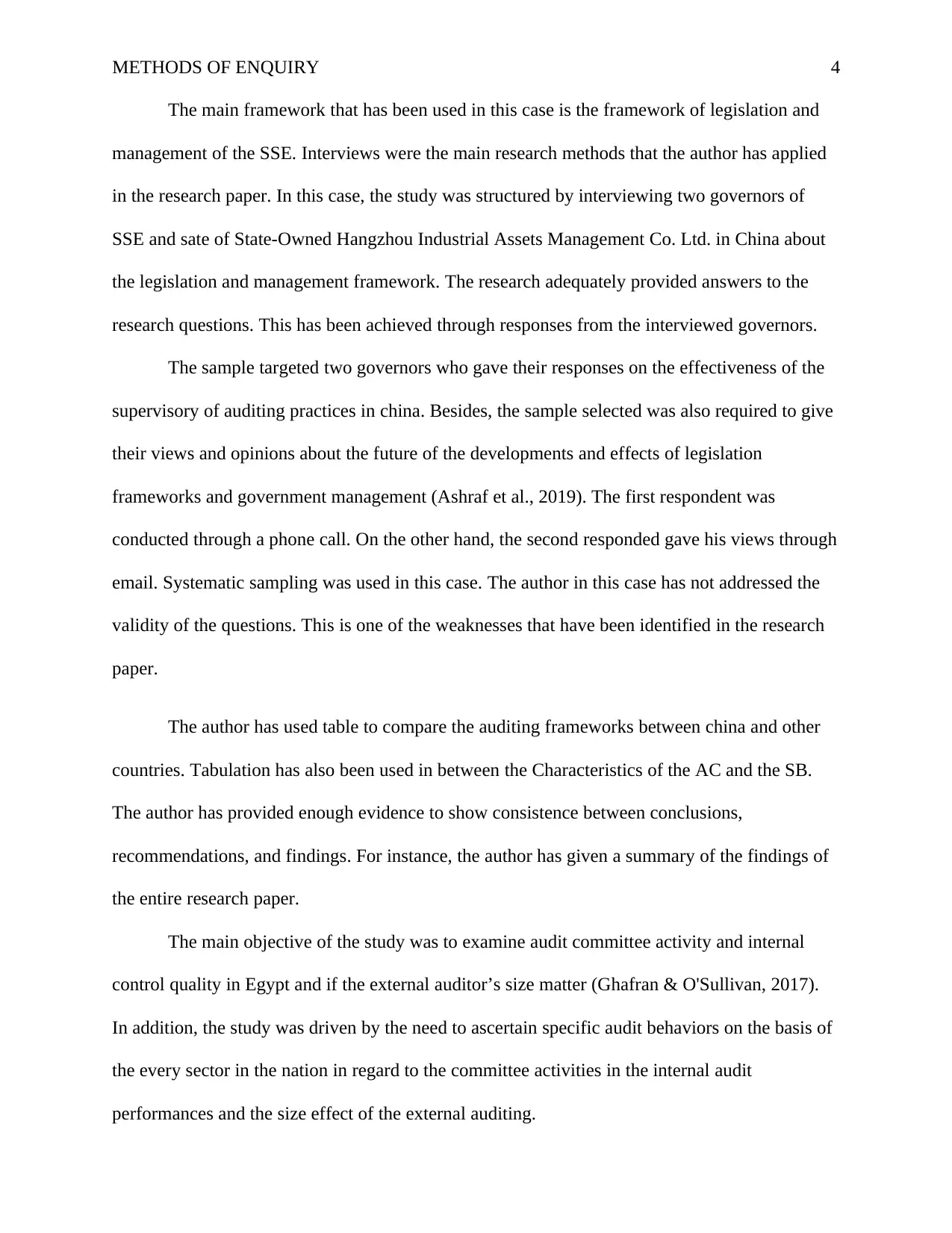
METHODS OF ENQUIRY 4
The main framework that has been used in this case is the framework of legislation and
management of the SSE. Interviews were the main research methods that the author has applied
in the research paper. In this case, the study was structured by interviewing two governors of
SSE and sate of State-Owned Hangzhou Industrial Assets Management Co. Ltd. in China about
the legislation and management framework. The research adequately provided answers to the
research questions. This has been achieved through responses from the interviewed governors.
The sample targeted two governors who gave their responses on the effectiveness of the
supervisory of auditing practices in china. Besides, the sample selected was also required to give
their views and opinions about the future of the developments and effects of legislation
frameworks and government management (Ashraf et al., 2019). The first respondent was
conducted through a phone call. On the other hand, the second responded gave his views through
email. Systematic sampling was used in this case. The author in this case has not addressed the
validity of the questions. This is one of the weaknesses that have been identified in the research
paper.
The author has used table to compare the auditing frameworks between china and other
countries. Tabulation has also been used in between the Characteristics of the AC and the SB.
The author has provided enough evidence to show consistence between conclusions,
recommendations, and findings. For instance, the author has given a summary of the findings of
the entire research paper.
The main objective of the study was to examine audit committee activity and internal
control quality in Egypt and if the external auditor’s size matter (Ghafran & O'Sullivan, 2017).
In addition, the study was driven by the need to ascertain specific audit behaviors on the basis of
the every sector in the nation in regard to the committee activities in the internal audit
performances and the size effect of the external auditing.
The main framework that has been used in this case is the framework of legislation and
management of the SSE. Interviews were the main research methods that the author has applied
in the research paper. In this case, the study was structured by interviewing two governors of
SSE and sate of State-Owned Hangzhou Industrial Assets Management Co. Ltd. in China about
the legislation and management framework. The research adequately provided answers to the
research questions. This has been achieved through responses from the interviewed governors.
The sample targeted two governors who gave their responses on the effectiveness of the
supervisory of auditing practices in china. Besides, the sample selected was also required to give
their views and opinions about the future of the developments and effects of legislation
frameworks and government management (Ashraf et al., 2019). The first respondent was
conducted through a phone call. On the other hand, the second responded gave his views through
email. Systematic sampling was used in this case. The author in this case has not addressed the
validity of the questions. This is one of the weaknesses that have been identified in the research
paper.
The author has used table to compare the auditing frameworks between china and other
countries. Tabulation has also been used in between the Characteristics of the AC and the SB.
The author has provided enough evidence to show consistence between conclusions,
recommendations, and findings. For instance, the author has given a summary of the findings of
the entire research paper.
The main objective of the study was to examine audit committee activity and internal
control quality in Egypt and if the external auditor’s size matter (Ghafran & O'Sullivan, 2017).
In addition, the study was driven by the need to ascertain specific audit behaviors on the basis of
the every sector in the nation in regard to the committee activities in the internal audit
performances and the size effect of the external auditing.
Paraphrase This Document
Need a fresh take? Get an instant paraphrase of this document with our AI Paraphraser
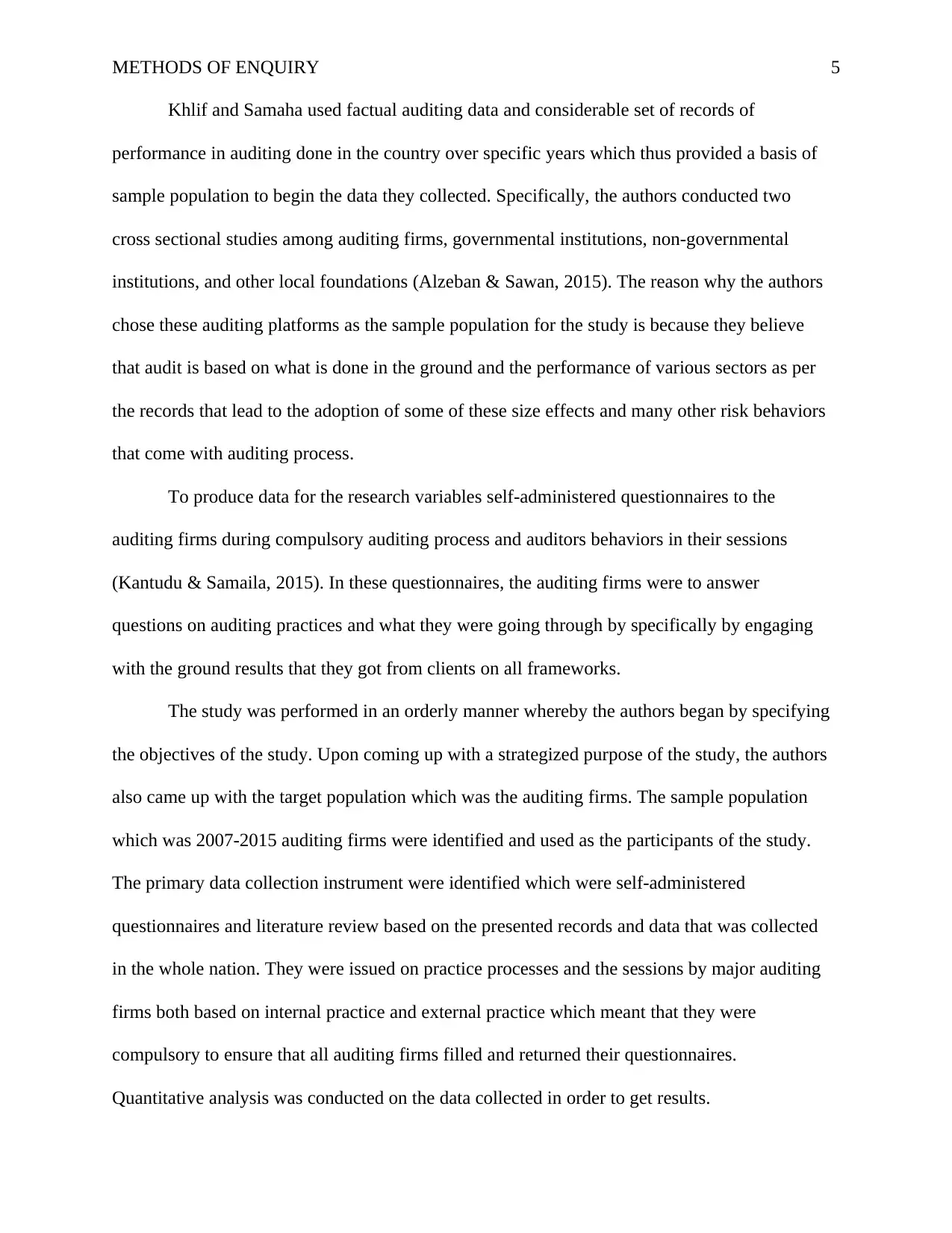
METHODS OF ENQUIRY 5
Khlif and Samaha used factual auditing data and considerable set of records of
performance in auditing done in the country over specific years which thus provided a basis of
sample population to begin the data they collected. Specifically, the authors conducted two
cross sectional studies among auditing firms, governmental institutions, non-governmental
institutions, and other local foundations (Alzeban & Sawan, 2015). The reason why the authors
chose these auditing platforms as the sample population for the study is because they believe
that audit is based on what is done in the ground and the performance of various sectors as per
the records that lead to the adoption of some of these size effects and many other risk behaviors
that come with auditing process.
To produce data for the research variables self-administered questionnaires to the
auditing firms during compulsory auditing process and auditors behaviors in their sessions
(Kantudu & Samaila, 2015). In these questionnaires, the auditing firms were to answer
questions on auditing practices and what they were going through by specifically by engaging
with the ground results that they got from clients on all frameworks.
The study was performed in an orderly manner whereby the authors began by specifying
the objectives of the study. Upon coming up with a strategized purpose of the study, the authors
also came up with the target population which was the auditing firms. The sample population
which was 2007-2015 auditing firms were identified and used as the participants of the study.
The primary data collection instrument were identified which were self-administered
questionnaires and literature review based on the presented records and data that was collected
in the whole nation. They were issued on practice processes and the sessions by major auditing
firms both based on internal practice and external practice which meant that they were
compulsory to ensure that all auditing firms filled and returned their questionnaires.
Quantitative analysis was conducted on the data collected in order to get results.
Khlif and Samaha used factual auditing data and considerable set of records of
performance in auditing done in the country over specific years which thus provided a basis of
sample population to begin the data they collected. Specifically, the authors conducted two
cross sectional studies among auditing firms, governmental institutions, non-governmental
institutions, and other local foundations (Alzeban & Sawan, 2015). The reason why the authors
chose these auditing platforms as the sample population for the study is because they believe
that audit is based on what is done in the ground and the performance of various sectors as per
the records that lead to the adoption of some of these size effects and many other risk behaviors
that come with auditing process.
To produce data for the research variables self-administered questionnaires to the
auditing firms during compulsory auditing process and auditors behaviors in their sessions
(Kantudu & Samaila, 2015). In these questionnaires, the auditing firms were to answer
questions on auditing practices and what they were going through by specifically by engaging
with the ground results that they got from clients on all frameworks.
The study was performed in an orderly manner whereby the authors began by specifying
the objectives of the study. Upon coming up with a strategized purpose of the study, the authors
also came up with the target population which was the auditing firms. The sample population
which was 2007-2015 auditing firms were identified and used as the participants of the study.
The primary data collection instrument were identified which were self-administered
questionnaires and literature review based on the presented records and data that was collected
in the whole nation. They were issued on practice processes and the sessions by major auditing
firms both based on internal practice and external practice which meant that they were
compulsory to ensure that all auditing firms filled and returned their questionnaires.
Quantitative analysis was conducted on the data collected in order to get results.
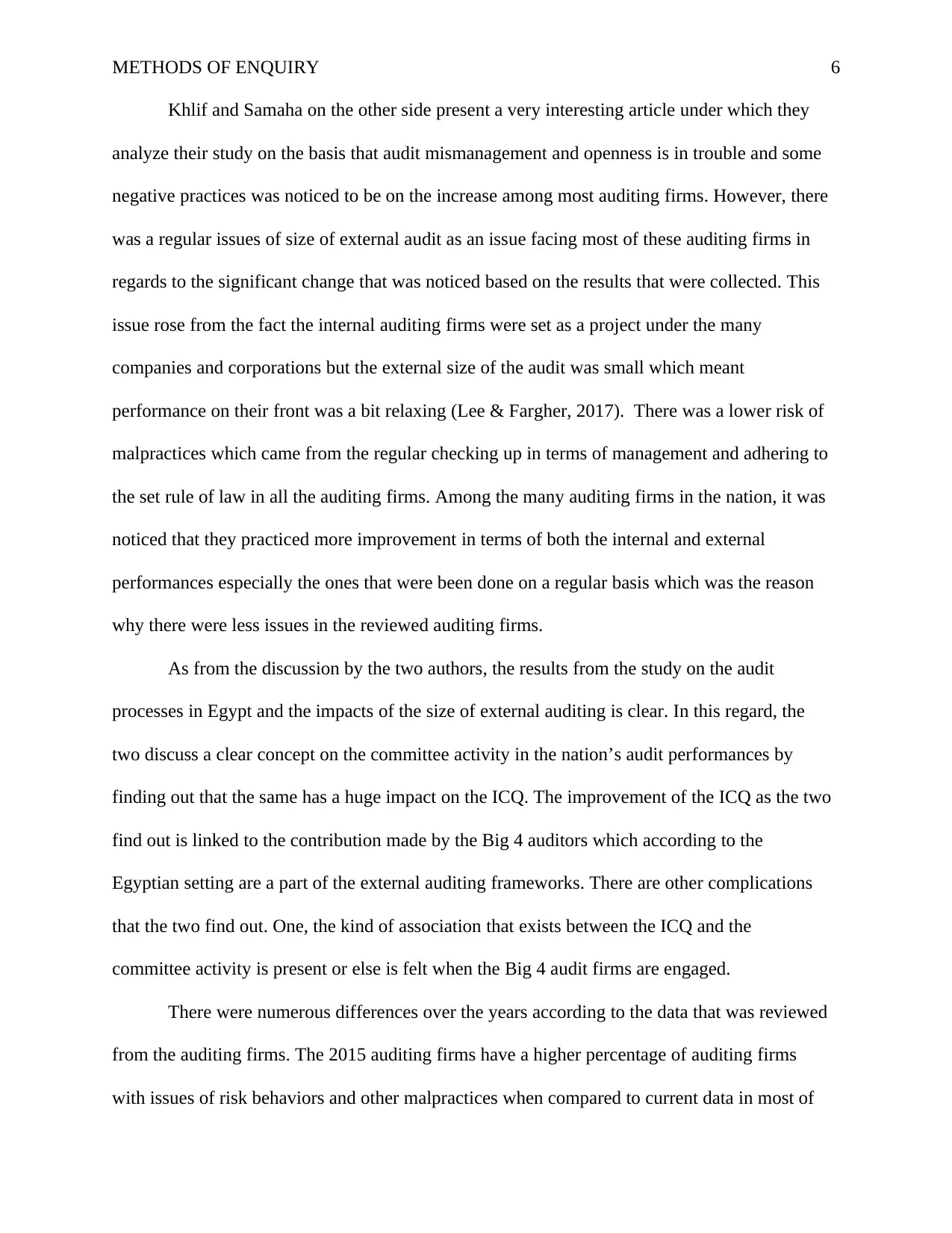
METHODS OF ENQUIRY 6
Khlif and Samaha on the other side present a very interesting article under which they
analyze their study on the basis that audit mismanagement and openness is in trouble and some
negative practices was noticed to be on the increase among most auditing firms. However, there
was a regular issues of size of external audit as an issue facing most of these auditing firms in
regards to the significant change that was noticed based on the results that were collected. This
issue rose from the fact the internal auditing firms were set as a project under the many
companies and corporations but the external size of the audit was small which meant
performance on their front was a bit relaxing (Lee & Fargher, 2017). There was a lower risk of
malpractices which came from the regular checking up in terms of management and adhering to
the set rule of law in all the auditing firms. Among the many auditing firms in the nation, it was
noticed that they practiced more improvement in terms of both the internal and external
performances especially the ones that were been done on a regular basis which was the reason
why there were less issues in the reviewed auditing firms.
As from the discussion by the two authors, the results from the study on the audit
processes in Egypt and the impacts of the size of external auditing is clear. In this regard, the
two discuss a clear concept on the committee activity in the nation’s audit performances by
finding out that the same has a huge impact on the ICQ. The improvement of the ICQ as the two
find out is linked to the contribution made by the Big 4 auditors which according to the
Egyptian setting are a part of the external auditing frameworks. There are other complications
that the two find out. One, the kind of association that exists between the ICQ and the
committee activity is present or else is felt when the Big 4 audit firms are engaged.
There were numerous differences over the years according to the data that was reviewed
from the auditing firms. The 2015 auditing firms have a higher percentage of auditing firms
with issues of risk behaviors and other malpractices when compared to current data in most of
Khlif and Samaha on the other side present a very interesting article under which they
analyze their study on the basis that audit mismanagement and openness is in trouble and some
negative practices was noticed to be on the increase among most auditing firms. However, there
was a regular issues of size of external audit as an issue facing most of these auditing firms in
regards to the significant change that was noticed based on the results that were collected. This
issue rose from the fact the internal auditing firms were set as a project under the many
companies and corporations but the external size of the audit was small which meant
performance on their front was a bit relaxing (Lee & Fargher, 2017). There was a lower risk of
malpractices which came from the regular checking up in terms of management and adhering to
the set rule of law in all the auditing firms. Among the many auditing firms in the nation, it was
noticed that they practiced more improvement in terms of both the internal and external
performances especially the ones that were been done on a regular basis which was the reason
why there were less issues in the reviewed auditing firms.
As from the discussion by the two authors, the results from the study on the audit
processes in Egypt and the impacts of the size of external auditing is clear. In this regard, the
two discuss a clear concept on the committee activity in the nation’s audit performances by
finding out that the same has a huge impact on the ICQ. The improvement of the ICQ as the two
find out is linked to the contribution made by the Big 4 auditors which according to the
Egyptian setting are a part of the external auditing frameworks. There are other complications
that the two find out. One, the kind of association that exists between the ICQ and the
committee activity is present or else is felt when the Big 4 audit firms are engaged.
There were numerous differences over the years according to the data that was reviewed
from the auditing firms. The 2015 auditing firms have a higher percentage of auditing firms
with issues of risk behaviors and other malpractices when compared to current data in most of
⊘ This is a preview!⊘
Do you want full access?
Subscribe today to unlock all pages.

Trusted by 1+ million students worldwide
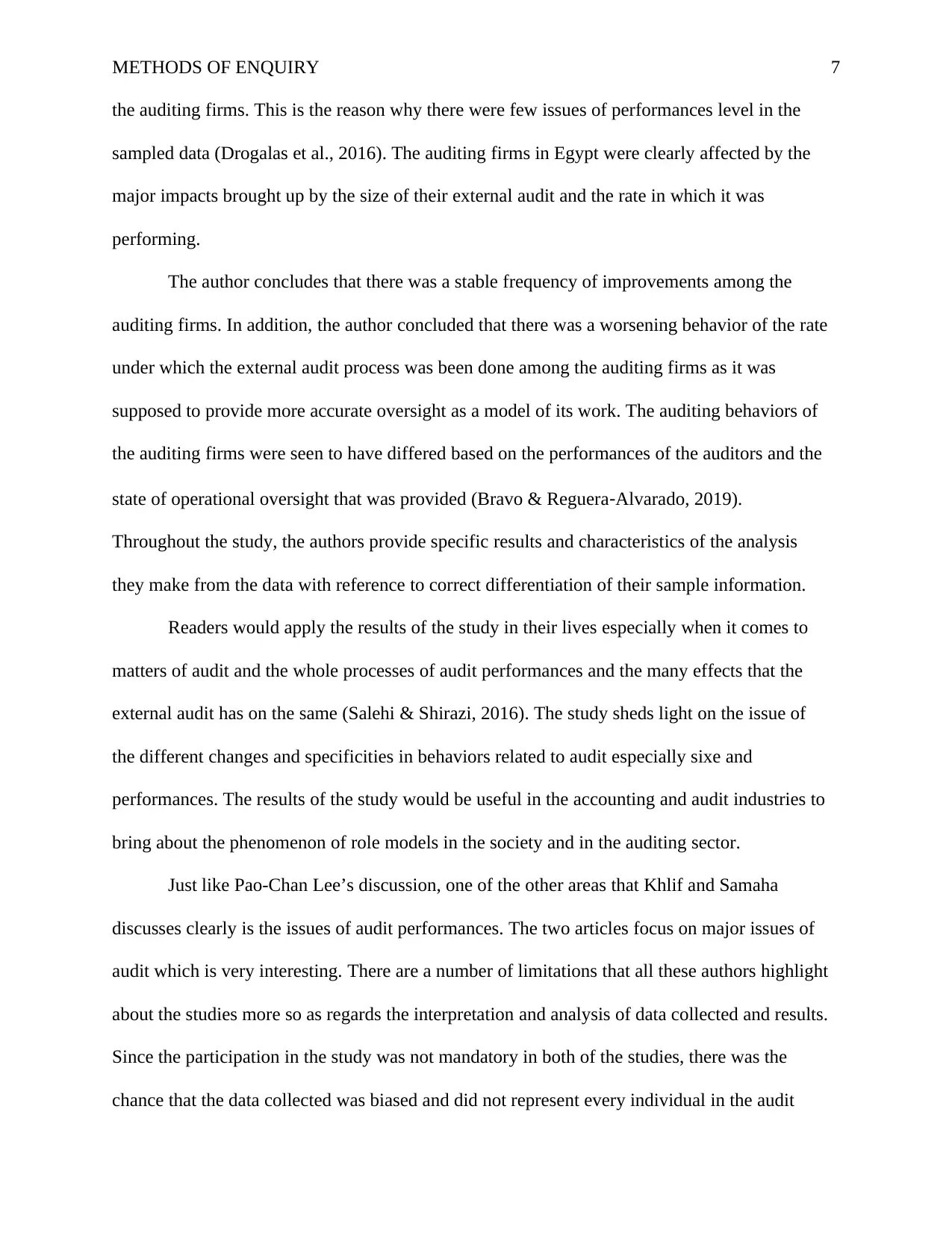
METHODS OF ENQUIRY 7
the auditing firms. This is the reason why there were few issues of performances level in the
sampled data (Drogalas et al., 2016). The auditing firms in Egypt were clearly affected by the
major impacts brought up by the size of their external audit and the rate in which it was
performing.
The author concludes that there was a stable frequency of improvements among the
auditing firms. In addition, the author concluded that there was a worsening behavior of the rate
under which the external audit process was been done among the auditing firms as it was
supposed to provide more accurate oversight as a model of its work. The auditing behaviors of
the auditing firms were seen to have differed based on the performances of the auditors and the
state of operational oversight that was provided (Bravo & Reguera‐Alvarado, 2019).
Throughout the study, the authors provide specific results and characteristics of the analysis
they make from the data with reference to correct differentiation of their sample information.
Readers would apply the results of the study in their lives especially when it comes to
matters of audit and the whole processes of audit performances and the many effects that the
external audit has on the same (Salehi & Shirazi, 2016). The study sheds light on the issue of
the different changes and specificities in behaviors related to audit especially sixe and
performances. The results of the study would be useful in the accounting and audit industries to
bring about the phenomenon of role models in the society and in the auditing sector.
Just like Pao-Chan Lee’s discussion, one of the other areas that Khlif and Samaha
discusses clearly is the issues of audit performances. The two articles focus on major issues of
audit which is very interesting. There are a number of limitations that all these authors highlight
about the studies more so as regards the interpretation and analysis of data collected and results.
Since the participation in the study was not mandatory in both of the studies, there was the
chance that the data collected was biased and did not represent every individual in the audit
the auditing firms. This is the reason why there were few issues of performances level in the
sampled data (Drogalas et al., 2016). The auditing firms in Egypt were clearly affected by the
major impacts brought up by the size of their external audit and the rate in which it was
performing.
The author concludes that there was a stable frequency of improvements among the
auditing firms. In addition, the author concluded that there was a worsening behavior of the rate
under which the external audit process was been done among the auditing firms as it was
supposed to provide more accurate oversight as a model of its work. The auditing behaviors of
the auditing firms were seen to have differed based on the performances of the auditors and the
state of operational oversight that was provided (Bravo & Reguera‐Alvarado, 2019).
Throughout the study, the authors provide specific results and characteristics of the analysis
they make from the data with reference to correct differentiation of their sample information.
Readers would apply the results of the study in their lives especially when it comes to
matters of audit and the whole processes of audit performances and the many effects that the
external audit has on the same (Salehi & Shirazi, 2016). The study sheds light on the issue of
the different changes and specificities in behaviors related to audit especially sixe and
performances. The results of the study would be useful in the accounting and audit industries to
bring about the phenomenon of role models in the society and in the auditing sector.
Just like Pao-Chan Lee’s discussion, one of the other areas that Khlif and Samaha
discusses clearly is the issues of audit performances. The two articles focus on major issues of
audit which is very interesting. There are a number of limitations that all these authors highlight
about the studies more so as regards the interpretation and analysis of data collected and results.
Since the participation in the study was not mandatory in both of the studies, there was the
chance that the data collected was biased and did not represent every individual in the audit
Paraphrase This Document
Need a fresh take? Get an instant paraphrase of this document with our AI Paraphraser
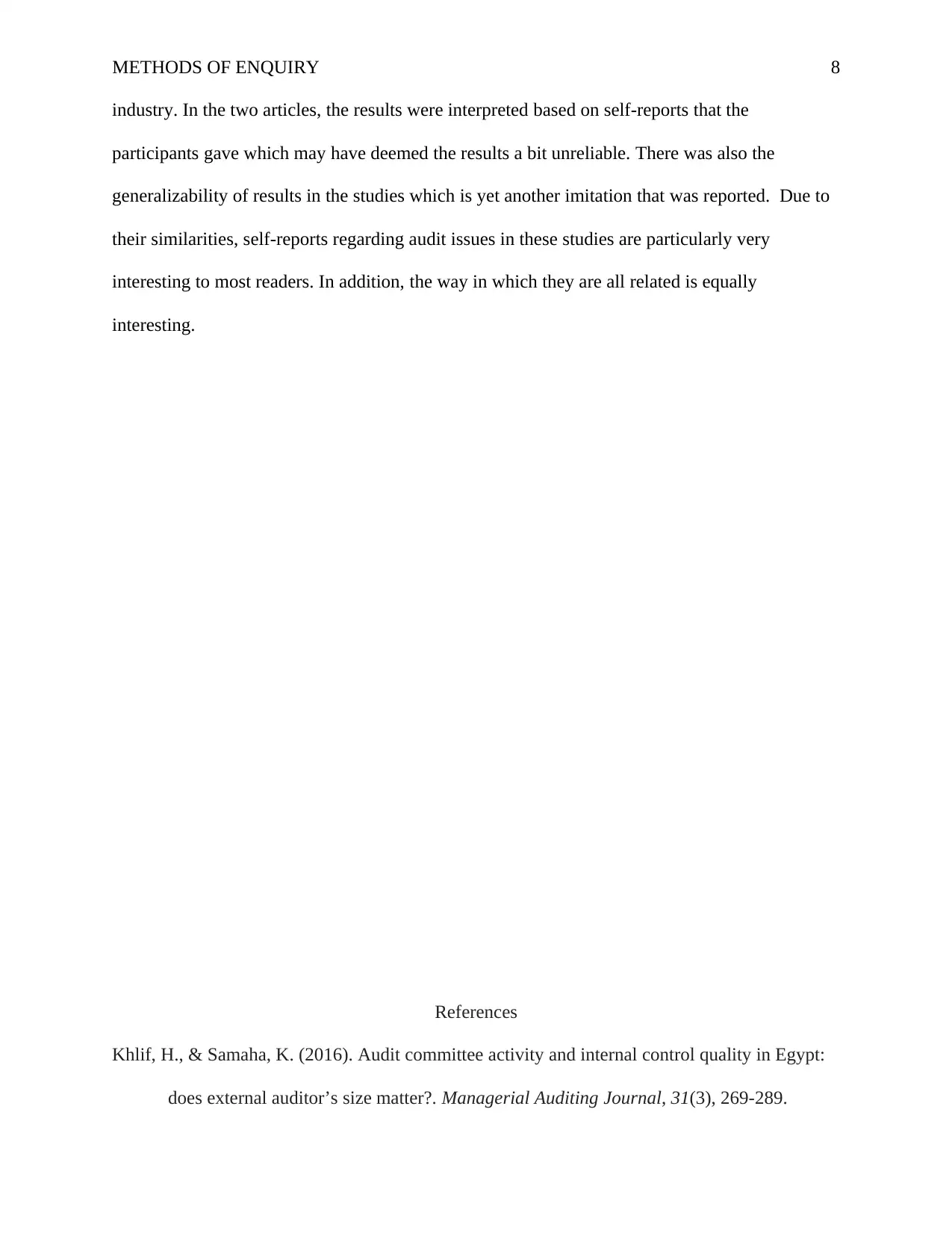
METHODS OF ENQUIRY 8
industry. In the two articles, the results were interpreted based on self-reports that the
participants gave which may have deemed the results a bit unreliable. There was also the
generalizability of results in the studies which is yet another imitation that was reported. Due to
their similarities, self-reports regarding audit issues in these studies are particularly very
interesting to most readers. In addition, the way in which they are all related is equally
interesting.
References
Khlif, H., & Samaha, K. (2016). Audit committee activity and internal control quality in Egypt:
does external auditor’s size matter?. Managerial Auditing Journal, 31(3), 269-289.
industry. In the two articles, the results were interpreted based on self-reports that the
participants gave which may have deemed the results a bit unreliable. There was also the
generalizability of results in the studies which is yet another imitation that was reported. Due to
their similarities, self-reports regarding audit issues in these studies are particularly very
interesting to most readers. In addition, the way in which they are all related is equally
interesting.
References
Khlif, H., & Samaha, K. (2016). Audit committee activity and internal control quality in Egypt:
does external auditor’s size matter?. Managerial Auditing Journal, 31(3), 269-289.
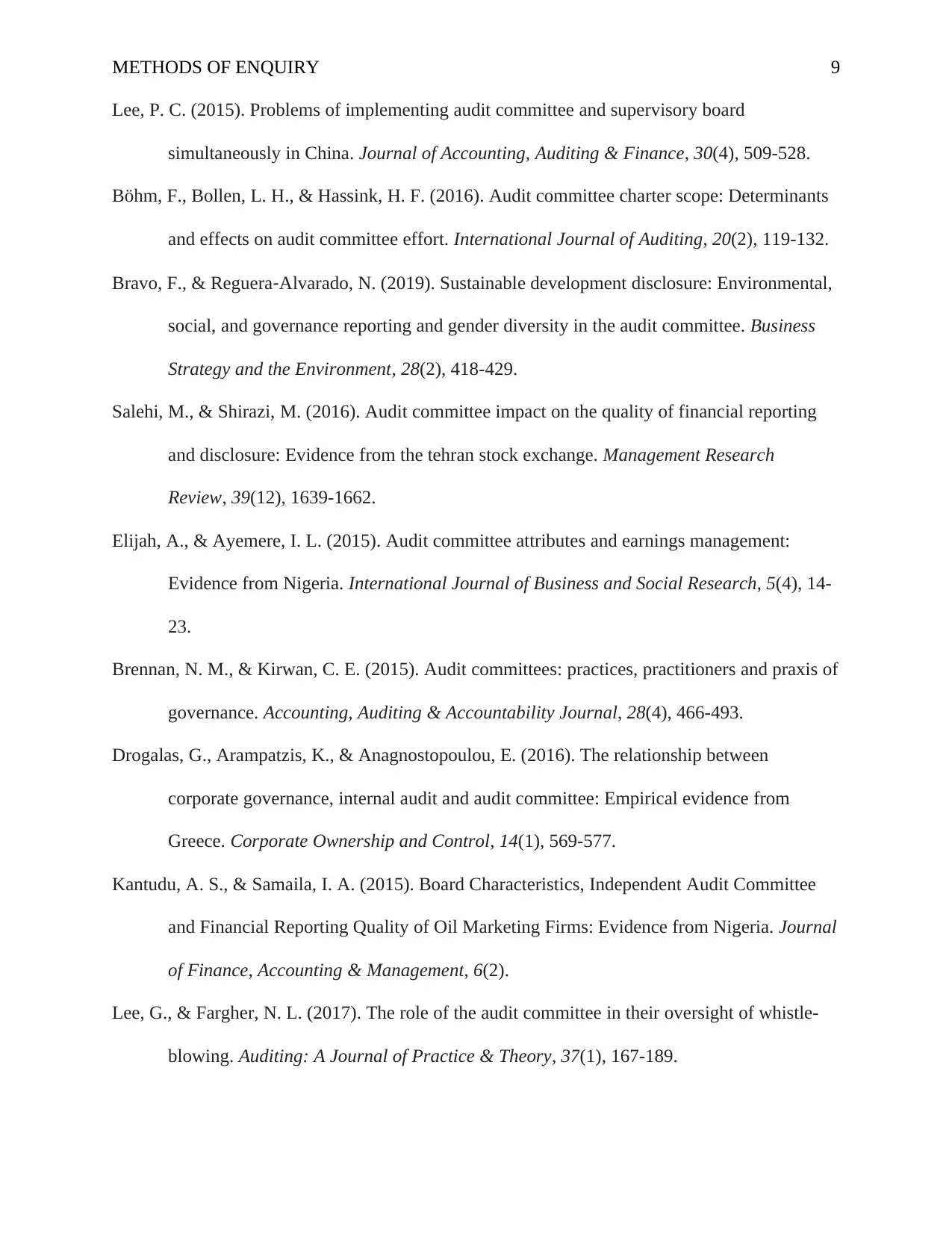
METHODS OF ENQUIRY 9
Lee, P. C. (2015). Problems of implementing audit committee and supervisory board
simultaneously in China. Journal of Accounting, Auditing & Finance, 30(4), 509-528.
Böhm, F., Bollen, L. H., & Hassink, H. F. (2016). Audit committee charter scope: Determinants
and effects on audit committee effort. International Journal of Auditing, 20(2), 119-132.
Bravo, F., & Reguera‐Alvarado, N. (2019). Sustainable development disclosure: Environmental,
social, and governance reporting and gender diversity in the audit committee. Business
Strategy and the Environment, 28(2), 418-429.
Salehi, M., & Shirazi, M. (2016). Audit committee impact on the quality of financial reporting
and disclosure: Evidence from the tehran stock exchange. Management Research
Review, 39(12), 1639-1662.
Elijah, A., & Ayemere, I. L. (2015). Audit committee attributes and earnings management:
Evidence from Nigeria. International Journal of Business and Social Research, 5(4), 14-
23.
Brennan, N. M., & Kirwan, C. E. (2015). Audit committees: practices, practitioners and praxis of
governance. Accounting, Auditing & Accountability Journal, 28(4), 466-493.
Drogalas, G., Arampatzis, K., & Anagnostopoulou, E. (2016). The relationship between
corporate governance, internal audit and audit committee: Empirical evidence from
Greece. Corporate Ownership and Control, 14(1), 569-577.
Kantudu, A. S., & Samaila, I. A. (2015). Board Characteristics, Independent Audit Committee
and Financial Reporting Quality of Oil Marketing Firms: Evidence from Nigeria. Journal
of Finance, Accounting & Management, 6(2).
Lee, G., & Fargher, N. L. (2017). The role of the audit committee in their oversight of whistle-
blowing. Auditing: A Journal of Practice & Theory, 37(1), 167-189.
Lee, P. C. (2015). Problems of implementing audit committee and supervisory board
simultaneously in China. Journal of Accounting, Auditing & Finance, 30(4), 509-528.
Böhm, F., Bollen, L. H., & Hassink, H. F. (2016). Audit committee charter scope: Determinants
and effects on audit committee effort. International Journal of Auditing, 20(2), 119-132.
Bravo, F., & Reguera‐Alvarado, N. (2019). Sustainable development disclosure: Environmental,
social, and governance reporting and gender diversity in the audit committee. Business
Strategy and the Environment, 28(2), 418-429.
Salehi, M., & Shirazi, M. (2016). Audit committee impact on the quality of financial reporting
and disclosure: Evidence from the tehran stock exchange. Management Research
Review, 39(12), 1639-1662.
Elijah, A., & Ayemere, I. L. (2015). Audit committee attributes and earnings management:
Evidence from Nigeria. International Journal of Business and Social Research, 5(4), 14-
23.
Brennan, N. M., & Kirwan, C. E. (2015). Audit committees: practices, practitioners and praxis of
governance. Accounting, Auditing & Accountability Journal, 28(4), 466-493.
Drogalas, G., Arampatzis, K., & Anagnostopoulou, E. (2016). The relationship between
corporate governance, internal audit and audit committee: Empirical evidence from
Greece. Corporate Ownership and Control, 14(1), 569-577.
Kantudu, A. S., & Samaila, I. A. (2015). Board Characteristics, Independent Audit Committee
and Financial Reporting Quality of Oil Marketing Firms: Evidence from Nigeria. Journal
of Finance, Accounting & Management, 6(2).
Lee, G., & Fargher, N. L. (2017). The role of the audit committee in their oversight of whistle-
blowing. Auditing: A Journal of Practice & Theory, 37(1), 167-189.
⊘ This is a preview!⊘
Do you want full access?
Subscribe today to unlock all pages.

Trusted by 1+ million students worldwide
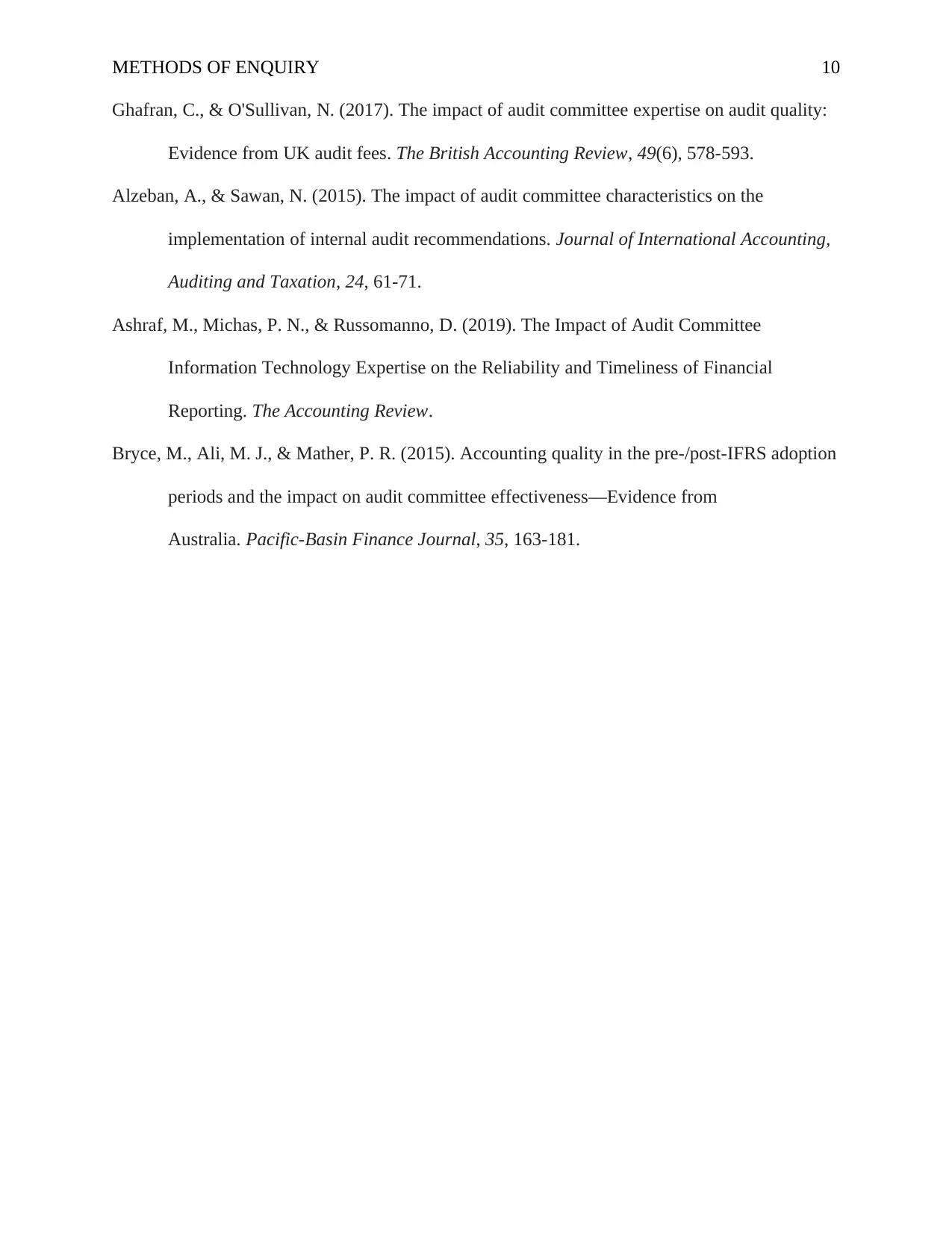
METHODS OF ENQUIRY 10
Ghafran, C., & O'Sullivan, N. (2017). The impact of audit committee expertise on audit quality:
Evidence from UK audit fees. The British Accounting Review, 49(6), 578-593.
Alzeban, A., & Sawan, N. (2015). The impact of audit committee characteristics on the
implementation of internal audit recommendations. Journal of International Accounting,
Auditing and Taxation, 24, 61-71.
Ashraf, M., Michas, P. N., & Russomanno, D. (2019). The Impact of Audit Committee
Information Technology Expertise on the Reliability and Timeliness of Financial
Reporting. The Accounting Review.
Bryce, M., Ali, M. J., & Mather, P. R. (2015). Accounting quality in the pre-/post-IFRS adoption
periods and the impact on audit committee effectiveness—Evidence from
Australia. Pacific-Basin Finance Journal, 35, 163-181.
Ghafran, C., & O'Sullivan, N. (2017). The impact of audit committee expertise on audit quality:
Evidence from UK audit fees. The British Accounting Review, 49(6), 578-593.
Alzeban, A., & Sawan, N. (2015). The impact of audit committee characteristics on the
implementation of internal audit recommendations. Journal of International Accounting,
Auditing and Taxation, 24, 61-71.
Ashraf, M., Michas, P. N., & Russomanno, D. (2019). The Impact of Audit Committee
Information Technology Expertise on the Reliability and Timeliness of Financial
Reporting. The Accounting Review.
Bryce, M., Ali, M. J., & Mather, P. R. (2015). Accounting quality in the pre-/post-IFRS adoption
periods and the impact on audit committee effectiveness—Evidence from
Australia. Pacific-Basin Finance Journal, 35, 163-181.
1 out of 10
Related Documents
Your All-in-One AI-Powered Toolkit for Academic Success.
+13062052269
info@desklib.com
Available 24*7 on WhatsApp / Email
![[object Object]](/_next/static/media/star-bottom.7253800d.svg)
Unlock your academic potential
Copyright © 2020–2025 A2Z Services. All Rights Reserved. Developed and managed by ZUCOL.





